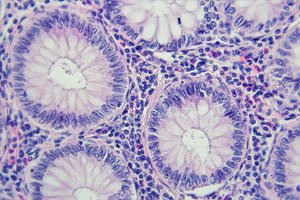
All iLive content is medically reviewed or fact checked to ensure as much factual accuracy as possible.
We have strict sourcing guidelines and only link to reputable media sites, academic research institutions and, whenever possible, medically peer reviewed studies. Note that the numbers in parentheses ([1], [2], etc.) are clickable links to these studies.
If you feel that any of our content is inaccurate, out-of-date, or otherwise questionable, please select it and press Ctrl + Enter.
New atlas maps 1.6 million human intestinal cells in detail with unprecedented accuracy
Last reviewed: 02.07.2025
 ">
">The most comprehensive map of human intestinal cells to date has been created by combining spatial and single-nucleus data from 1.6 million cells.
Mapping gut cells could provide more insight into what’s going on in diseases like bowel cancer and inflammatory bowel disease (IBD). Using the atlas, researchers at the Sanger Institute and their colleagues have identified a new role for a particular gut cell that may be involved in a cycle of inflammation in some people, causing pain and discomfort.
The study, published in the journal Nature, describes how the team combined more than 25 single-core human gastrointestinal (GI) datasets to create the world’s largest freely available gut data resource. This resource includes samples from both healthy individuals and those suffering from various diseases.
The Meaning of the Gut Cell Map
By better understanding the structure of the gut in health and disease, researchers can identify key changes that may be associated with the onset of diseases such as ulcerative colitis and Crohn's disease, as well as discover new targets for drug development.
This article is part of a series of publications (Nature Portfolio) associated with the Human Cell Atlas project that represent significant advances in our understanding of the human body. These studies illuminate key aspects of developmental biology, health and disease, and contribute to the development of analytical tools that will aid in the development of a human cell atlas.
The GI tract includes the organs responsible for digestion, from the mouth to the anus. It performs important functions such as absorbing nutrients and protecting against pathogens. Gastrointestinal diseases affect millions of people worldwide. For example, ulcerative colitis and Crohn's disease affect more than 7 million people. These diseases are characterized by symptoms such as abdominal pain, diarrhea, rectal bleeding, fatigue, and joint problems.
Bowel cancer, also known as colorectal cancer, is the fourth most common cancer in the UK, with almost 43,000 people diagnosed each year. There are around two million cases worldwide.
Creating a harmonized resource
Because of the importance of these diseases, many single-nucleus studies of GI cell structure have been conducted. However, fragmented data and methods have made it difficult for outside researchers to use these resources.
To address this issue, the researchers developed a data harmonisation tool, creating a standardised resource of gut cells that is accessible to scientists around the world. The tool can also be applied to other organs for further research.
The resulting atlas combines 25 datasets and includes 1.6 million cells with single-nucleus and spatial data, providing information on cell types, their locations, and interactions with the environment. The atlas includes data from healthy individuals as well as patients with gastro- and colorectal cancers, celiac disease, ulcerative colitis, and Crohn's disease.
Discovery of a new role for cells
The team discovered a type of cell known as intestinal metaplastic cells that may be involved in inflammation. These cells, which are normally involved in repairing the lining of the stomach, showed genetic similarities to other GI cells associated with inflammation. The scientists speculate that the inflammation in IBD causes changes in these cells, increasing inflammation.
Application of the atlas
The atlas is available free of charge, and new processes have been developed to allow future research data to be added, creating a dynamic and accessible resource for scientists.
Dr Amanda Oliver, first author from the Sanger Institute, said:
"The spatial and single-nucleus data provide unique insights into how gut cells interact, helping to better understand how the human body works. We hope that researchers will continue to build on this resource, adding new insights to improve human health."
Dr Rasa Elmentaite, co-author of the study, added:
"This integrated atlas includes a huge amount of data, allowing us to identify pathogenic cell types that could be targets for future interventions."
Professor Sarah Teichmann, co-founder of the Human Cell Atlas, said:
"This atlas demonstrates what can be achieved through open collaboration between scientists from around the world. It is a powerful tool for understanding diseases and developing new treatments."
